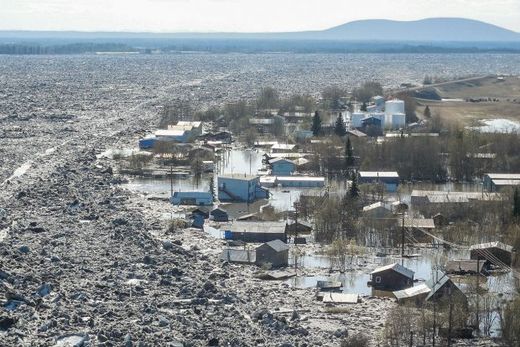
Forever winter
2013 started off with a bang, with January bringing the coldest weather of the year to the state, the National Weather Service writes. The Interior community of Delta shivered through the lowest official temperature of the year, at 63 below zero on Jan. 28.
Related: Families from Galena still displaced by flooding, but holiday traditions go onWith sewer offline in flood-damaged Kotlik, residents welcome aid in form of honeybuckets
Anchorage saw its longest snow season since 1917, with the first snow recorded Sept. 28, 2012, and the last of the season on May 18, for a total of 232 days with snow in the 2012-2013 winter.
Winter hung on into Mid-May for much of the state, the effects of which reverberated through communities across Alaska.
'Spring from hell'
A chilly spring wreaked havoc on Alaska residents, and the National Snow and Ice Data Center later confirmed that the "spring from hell" was far colder than normal.
Interior Alaska saw its coldest April since 1924, the NWS writes. Juneau had its latest snowfall on record on April 26, with 4.4 inches falling on the Southeast city, said NWS meteorologist Aaron Jacobs on Tuesday.
A late spring break-up and rapid thaw directly affected flooding along the Yukon River, which brought massive floods to communities in late May and Early June. The state of Alaska would go on to declare a disaster emergency for much of the region; state officials are calling the Yukon River flood of May 2013 the worst natural disaster in Alaska for decades. The Interior community of Galena was hit the hardest -- nearly every structure in the community was damaged by flood waters and massive chunks of ice that smashed into homes and left roughly 500 residents displaced.
In the Interior town of Denali, frigid mid-May weather caused businesses to remain closed for weeks into their tourist season, freezing pipes and delaying openings as visitors started to arrive at the park.
The chilly spring also caused problems for farmers in the Matanuska-Susitna Valley, whose operations were delayed by several weeks due to late snow melt and mud.
Even the birds were affected by the chilly spring weather. Summer migration was delayed and an unexpected bonanza of migrating birds were reportedly hunkering down in Denali National Park and Preserve in mid-May.
Late summer, record heat
A late-blooming summer burst into a record-breaking heat wave in many parts of the state.
In Amber Lake, southwest of Talkeetna, a high of 97 degrees on June 17 nearly toppled the all-time high record of Alaska, falling shy by just three degrees. That record high of 100 degrees was set in June 1915 in the Interior community of Fort Yukon.
Fairbanks didn't see a 60-degree day until May 20. A week later, the Interior community had hit 80 degrees and was well on its way to a sultry summer. All told, Fairbanks had a record 36-day stretch of temperatures of 80 degrees or higher, smashing the nearly century-old record set in 1915 of 30 days above 80 degrees in a summer.
Anchorage was similarly hit with a heat wave in June and July, with balmy temperatures a major turnaround after five years of cool summer temperatures.
Juneau had the 2nd hottest year on record, Jacobs said.
Barrow had the warmest combined June and July, and the island of Kodiak saw the fourth-warmest June, July and August, NWS writes.
The wet autumn, late spring, and dry summer affected farms in Fairbanks, Delta and throughout Southcentral and played a role in a hay shortage in the state.
The flowers of autumn?
October 2013 was the warmest on record for Interior Alaska, NWS writes. In Fairbanks, mid-October temperatures in the 50s and 60s even revived some plant life.
Autumn brought wet weather to Southcentral. The Kenai Peninsula was hit with heavy rains and flooding in September and October.
In Anchorage, September and October were the first time that consecutive months had more than 5 inches of rain each. NWS meteorologist Tom Pepe said Tuesday that 2013 will likely go down in record books as the second wettest year on record for Anchorage.
Anchorage's autumn weather, Pepe said, "flip-flopped a lot," with temperatures above and below zero, before settling into a more regular pattern come winter.
In Southeast, an abnormally warm autumn in the southern half of the Alaska Panhandle resulted in low power generation for residents relying on hydroelectric power, with many reservoirs 14 feet below normal, Jacobs said.
...And back to winter again
In November, Fairbanks was hit with winds that knocked out power to thousands of homes for days.
Meanwhile, across the Western Alaska coast, a series of storms battered communities, leading to a disaster declaration by Gov. Parnell for both the western coast and the Kenai borough following autumn floods.
Cold Bay, a community nestled at the tip of the Alaska Peninsula, saw its warmest October and December on record -- making it to the warmest year on record.
Barrow saw the wettest December on record.
In Anchorage, a snowfall on Dec. 14 broke the daily record dumping 8.5 inches of snow, with Girdwood being walloped with 26 inches.
In Southeast Alaska, communities had an unusually snowy December, Jacobs said. Juneau had 40 inches of snow during the month, 24 inches above normal. Haines had a whopping 91.8 inches of snowfall in December.



Reader Comments
to our Newsletter